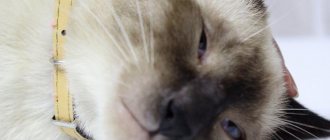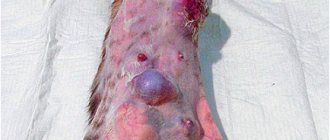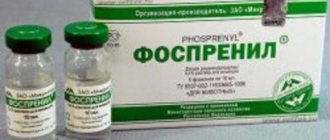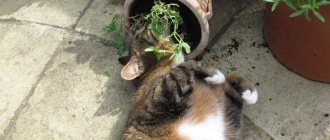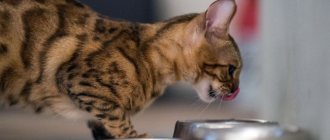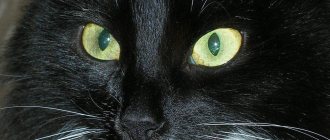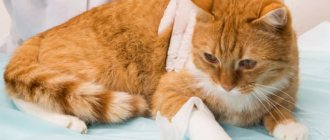If a cat's face is swollen, the reason for this may be a number of different factors, some of which are quite life-threatening for the pet. It is not always possible to notice a tumor in time, especially when the cat is long-haired. However, once the problem has been identified, it is important to visit a veterinary clinic as soon as possible to determine the cause of the lump.
What is edema?
Fluid retention in animal tissues occurs for various reasons.
There are two mechanisms for fluid accumulation:
- hydrostatic, associated with increased pressure in small vessels;
- hypoprotemic, associated with a violation of the protein content in the liquid part of the blood (plasma).
In the latter case, the permeability of small vessels increases due to inflammation, disorders of nervous regulation or toxic lesions.
The fluid that accumulates in the tissues can also be different:
- blood;
- lymph;
- pus.
Edema may vary in area and symmetry:
- they are limited (localized) and generalized (general);
- symmetrical and asymmetrical (for example, only one paw swells).
Limited swelling affects a small area of the body or organ. General ones cover large areas and indicate serious illnesses and a poor prognosis for the life of the animal.
Edema is caused by a condition called pre-edema. Predotec describes the state of preliminary accumulation of fluid in organs or tissues.
Dermatological diseases
The cat's body is susceptible to autoimmune diseases. In such cases, the immune system attacks the body's own tissues where the target cells are located. Dermatoses of this type include:
- Pemphigus foliaceus. The intercellular epidermal tissue is affected, which leads to the appearance of pustular rashes on the face. May be accompanied by hyperthermia, lethargy, and refusal to eat. A biopsy of the affected areas is necessary.
- Common pemphigus. The epidermis stratifies with the formation of bubbles filled with liquid, which burst, turning into ulcers on the nose, lips and in the oral cavity. May be fatal. A histological examination of the damaged mucosa is required.
- Erythematous pemphigus. Most often, only the nose is affected. Accompanied by pigmentation disorders, rashes, ulceration of the nasal planum, bridge of the nose and bridge of the nose, and the formation of scabs.
- Pemphigus vegetans. A relatively mild form of dermatosis. Main symptoms: rash and blisters.
- Systemic lupus erythematosus. Skin manifestations are observed in the discoid form, involving the nose, ears, eyelids, lips. The process begins with changes in pigmentation and redness, then ulcers form. Systemic disorders include: damage to the hematopoietic system (anemia, decreased blood clotting), kidneys, joints, gastrointestinal tract, central nervous system. Tests for antinuclear antibodies and a biopsy of the epidermis are necessary.
- Vasculitis. The disease affects blood vessels, which leads to a deterioration in the blood supply to tissues and their subsequent death. Most often, the nose, lips, tip of the tail, ears, paw pads, and genitals are affected.
- Cold agglutinin disease. Reason: at low ambient temperatures, red blood cells interact with immunoglobulins. The same areas are damaged as with vasculitis. They acquire a bluish coloration, pigmentation is disrupted, and hair falls out. In severe cases, necrosis may occur.
Rhinotracheitis, calcivirosis and other upper respiratory tract infections
Feline upper respiratory tract infection is a general term for respiratory infections caused by one or more viral or bacterial agents.
The infection may be caused by one or more viral and/or bacterial agents. The most common viruses that cause upper respiratory tract infections in cats are:
- Herpesvirus type 1 is also known as feline rhinotracheitis virus or FVR.
- Calcivirosis (FCV).
The most common bacteria that cause upper respiratory tract infections in cats are:
- Bordetella bronchiseptica.
- Chlamydophila felis.
Rhinotracheitis and calcivirus cause approximately 90% of all secondary respiratory tract infections in cats. Other, less common pathogens that can lead to purulent discharge and inflammation of the nose are:
- Mycoplasmosis.
- Rotavirus.
What do you need to know about the problem?
One of the most common problems veterinarians include is subcutaneous formations that can appear anywhere. In a cat, a lump on the nose may indicate the development of a cyst, an enlarged lymph node, hemorrhage, the presence of a foreign object or even a tumor. At the first signs of formation, owners need to conduct an independent inspection.
If the cat is irritated, then the animal should be examined with calm stroking movements of the hands. The purpose of this physical examination is to identify similar lesions in other locations. If there are no subcutaneous growths on the body, hemorrhage due to a blow or scratch should then be excluded. If your pet loves to get into fights with neighbor cats, then in this case there is a high probability of an ordinary wound received from the claws of rivals.
In a cat, a lump on the nose is often a benign formation. As the tumor develops, it gradually grows while maintaining its structure. A congenital bump on the nose is a nasal glioma. It does not cause pain or discomfort, but may begin to grow inside the nasal passages. In some cases, the lump makes breathing difficult, in which case it must be removed surgically.
Causes of swelling
Swelling never occurs normally. The appearance of tissue swelling is always preceded by a pathological process.
Allergic edema
One of the most common causes of edema in cats is an allergic reaction. She might be local. But often an allergic reaction occurs in the form of angioedema. To the bite of poisonous insects, an allergy develops at the site of the bite. The animal's nose or paw swells greatly, the animal suffers from itching and pain at the site of the bite, and the temperature of the tissues at the site of the bite may be slightly elevated.
A typical reaction to flea excrement and parasite saliva is swelling of the animal's lips and even the entire muzzle. This is justified by the fact that insect waste products fall on the cat’s mucous membranes when licking. The same swelling can be a sign of a reaction to chemicals and even foods. In this case, apart from the swelling itself, there are no signs of inflammation. The skin is of normal color, not painful.
Traumatic edema
Edema of traumatic origin occurs at the site of injury (bruise or fracture), edema develops at the site of a bite by another animal or puncture of tissue with a sharp object.
In the first case, it is caused by tissue destruction at the site of injury.
In the second, the entry of a foreign body contaminated with pathogens or bacteria on the animal’s fang and rotting processes in damaged tissues.
If such swelling occurs when a fang bites the lip, the animal cannot chew; any movements of the jaws cause pain to it. With post-traumatic edema, the animal avoids touching the site of injury. The skin at the site of injury is hyperemic, and the local temperature is elevated.
Edema associated with internal organ disease
Partial swelling affecting only the pet's hind legs is a sign of a serious pathology (heart disease or kidney failure). In this situation, most often both limbs swell (the swelling is symmetrical). In renal failure, swelling begins at the animal's fingertips and gradually rises upward. The swelling is not painful, the skin does not feel hot, the animal may not even notice it, moving as usual.
Swelling caused by joint disease
This swelling is often asymmetrical. It occurs in the joint area, accompanied by pain and hyperemia, stiffness when moving. The cat limps while moving, and sometimes it is very painful for her to step on her paw.
Edema due to venous insufficiency
Vascular pathologies do not escape even four-legged pets. Cats can have venous congestion, leading to edema. The cause of swelling may be a blood clot. It mechanically blocks the movement of blood through the vessel. This swelling is asymmetrical and is accompanied by unpleasant sensations in the affected limb. Thrombosis and thrombophlebitis, increased permeability of the vascular wall are a common cause of edema.
Tumors as a cause of edema
With tumors of the mammary glands, the animal's paw on the affected side may swell. Such swelling can be quite noticeable. The skin is usually not hyperemic. Edema develops due to mechanical compression of the lymphatic ducts by tumor growth.
Hematoma at the withers
Often after injections, lumps appear on the skin. This happens in two cases - the injection is placed incorrectly or the injection solution is too thick.
The lump after an injection into the withers of a cat is not dangerous and acts as nothing more than an ordinary hematoma. It resolves after a few days and does not require specific treatment. You should consult a doctor if there is an increase in skin temperature around the lump, and the animal constantly tries to comb the sore area.
Among the reasons for the appearance of bumps on the neck and withers in animals, injuries should also be noted. If an animal walks freely on the street, it can fight with a fellow animal, and a seal forms at the site of the bite. Such an injury is dangerous with the risk of abscess formation, so it should be immediately treated with an antiseptic.
In all other cases, you should not try to treat the cat yourself, or hope that the lump will resolve. Only a specialist can make an accurate diagnosis and relieve the animal of discomfort.
Prevention
Walking your cat on a leash will help you avoid unnecessary injuries or fights with other animals.
To reduce the likelihood of facial swelling in cats, veterinarians recommend that owners carefully monitor their pets. It is better not to let them go outside alone, which will protect the animals from fights, injuries and bites. Walking without an owner is most dangerous for cats that are over 3 months old. Their fear has already disappeared, but the kittens have not yet fully grown up to adequately assess the threats and fight back the offender. It is important for cat owners to remember that industrial complementary foods sold in stores can cause allergic reactions. If a decision has been made to diversify your pet’s diet with a new food, it is recommended to introduce it gradually, observing the response of the animal’s body. An important preventive measure is a systematic examination of the cat, its ears, eyes, nose and mouth. You should attend routine medical examinations with your pet at a veterinary clinic, which will help identify the development of pathologies at the initial stages.
Malignant neoplasms
A soft lump on a pet's neck can pose a threat to the cat's life. In older animals, the appearance of a neoplasm may indicate oncology.
Malignant lumps do not have specific symptoms; only a specialist can make a diagnosis. As a rule, with cancer, a cat feels unwell and lacks strength, refuses to eat, and begins to lose weight. Since these symptoms are common to other diseases, you should immediately show the animal to a specialist.
To make a diagnosis, the doctor will do an X-ray or MRI. If a malignant tumor is suspected, a biopsy is performed - removal of particles of the tumor for the purpose of histological examination of tissue cells. Based on the results of histology, a decision is made on further treatment. The lump must be completely removed, and the animal is prescribed a course of chemotherapy.
Oral cancer is not common, but in three out of a hundred cats it causes growths in the area where the whiskers grow. Therefore, if your cat has a bump on its cheek, contact your veterinarian.
Treatment of such diseases is not carried out at home; surgical removal of the bump on the cheek is prescribed. Chemotherapy is used to prevent metastases. However, with a progressive tumor and advanced disease, the cat cannot be cured.
Lymphadenitis
When the lymph nodes (submandibular, axillary) are inflamed, the inflamed tissues swell greatly, the area of edema is very painful on palpation. When the submandibular lymph nodes are inflamed, the animal cannot chew (the process is very painful).
Swelling after sterilization
Postoperative swelling is not uncommon. Swelling and redness may be observed in the scar area. This occurs due to swelling of the internal sutures. No treatment is required; after the internal sutures are absorbed, this swelling goes away on its own.
Routes of infection
The causative agents of rhinotracheitis and calcivirosis are widespread. The carrier spreads the virus throughout the environment through saliva, nasal discharge, feces and urine. Vaccinated cats become infected through contact with carriers. Animals that have not received vaccination are at risk of getting sick from contact with soil, water and environmental objects.
In most cases, cats become infected through direct contact with a carrier, as viruses and bacteria can survive in the environment for up to 18–24 hours. The danger of rhinotracheitis and calcivirosis is that a visually healthy (recovered) animal can remain a carrier for a long time.
Treatment
First aid depends on the cause of the swelling. If the swelling is caused by a blow or bruise, cold can be applied to the site of the bruise in the first day after the injury. The next day, the injury site needs to be warmed up.
If the swelling is cold, it is sometimes recommended to knead the animal’s limb to restore blood circulation. If blood flow is disrupted, this can bring relief to the pet, but in the case of thrombosis, massage can cause a blood clot to break off and embolism.
In case of “hot” swelling, it is recommended to apply cold compresses. This is acceptable for insect bites. But in the case of inflammatory processes, specific treatment with antibacterial agents is necessary.
If there is swelling, it is worth taking your pet to the veterinarian to find out the cause of the phenomenon and prescribe proper treatment.
Additional signs that usually accompany a bump on the nose
If the tumor is caused by a fight with other pets, it is not difficult to determine - scratches, abrasions, and even blood will be found on the cat's body. If the injury is too serious, it is best to go to the vet immediately - you may need stitches. If the abrasions are minor, you can help the animal yourself - treat it with antiseptics, apply a cold compress to the nose. In case of infectious diseases, a growth on a cat’s nose is accompanied by the following symptoms:
- a cloudy liquid with an unpleasant odor is released from the eyes;
- the pet refuses to eat;
- the animal becomes apathetic, lethargic, and shows no interest in anything;
- The coat loses its shine and bald patches appear.
Inflammatory processes are not difficult to determine - the cat is constantly sneezing, breathing is difficult, and wheezing is clearly audible. The pet often shakes its head and becomes nervous when its owners approach. Fluid is released from the nasal passages, which may be clear or yellowish, mixed with pus.
Snake bite
Cats also often become victims of snake bites. Of course, this is not typical for pets living in an apartment and not going outside. But for cats who live in the house or come to the country in the warm season - it’s fine.
Of course, the greatest danger comes from the bites of poisonous reptiles. This may well lead to shock and even death of the animal. However, even the bite of non-venomous snakes poses a certain threat. Primarily due to the fact that during a bite a wound is formed, into which infection from the snake’s teeth enters. Because of this, a focus of inflammation arises, which can lead to dire consequences.
To prevent this from happening, you need to use antibiotics. But there is no particular rush here - it is enough to take action in the next few hours.
But if you are bitten by a poisonous snake, you need to act as quickly as possible. Alas, not every home medicine cabinet has an antidote, so it is advisable to immediately visit a veterinarian. Along with the antidote, he may give an injection of diphenhydramine. After the shock has been relieved and the effects of the poison have been eliminated, the doctor may also prescribe broad-spectrum antibiotics to eliminate the possibility of inflammation.
Reasons why cats lose hair
Veterinarians identify several reasons that can affect hair loss, which becomes significant and worries the owner:
- Seasonal molt
. This process may not cause concern if the hair loss is severe, but the cat does not experience discomfort. His nose is moist, his skin is clear, normal color, and there is no discharge from his eyes. If your cat has lost hair on her neck, this may be a sign of shedding. This is a natural and normal seasonal process. In pets, it can last for almost three months. This, of course, annoys the owners who have to remove scraps of fur. But new vegetation will grow to replace the old one, and we just need to help the process and promote its growth. This can be done by enriching the cat's nutritional diet with natural foods rich in minerals and vitamins. - Diet
. Nutrition has a significant impact on all body functions, as well as on the condition of the skin and hair. An unbalanced diet can lead to a condition that causes cats to lose hair profusely, especially on the back, tail, and neck. The rest may become dull. The most unpleasant thing for a cat can be redness, peeling and itching of the places where it fell out. This most often occurs when feeding a pet sausage, sausages, and in general foods high in fat, spices and salt. We also note the fact that a large amount of whole milk in an animal’s diet can cause hair loss. - Hormonal disorders
. Veterinarians note that often owners of animals who are given drugs that suppress attraction to the opposite sex complain that their hair is falling out a lot. In this case, wounds and ulcers may appear at the site of baldness. A change in the pet’s behavior was also noticed: lethargy, loss of appetite, as well as a change in body weight towards a decrease or significant increase. - Allergic reactions
. Cats are prone to allergies, mainly food ones. Certain products can cause hair loss and a number of unpleasant symptoms: inflammation of the ears, redness of the skin in areas of bald patches and severe itching that bothers the animal; the cat is constantly itching. - Immune problems
. A disease suffered by a pet and drug treatment can cause severe hair loss. But this is only a temporary phenomenon that will gradually pass when the body gets stronger. - Facial alopecia
. This term describes hair loss in cats between the eyes and ears. The process is natural and does not relate to the disease. It can appear in a cat between the second and third years of life.
Dental diseases
A swollen face in a pet can be caused by dental problems. If the cat's face is swollen, and an allergy is definitely excluded, it is necessary to carefully examine the oral cavity. Broken teeth can irritate the tissue around them, potentially causing swelling. Swelling of the gums, in turn, leads to pronounced swelling of the lower or upper jaw, depending on the location of the broken tooth.
Another reason is gumboil or purulent abscess of the gums. This pathology is manifested by a bacterial infection that has entered the soft tissue of the mucosa. As a result, an abscess forms in the affected area - a large cavity filled with pus. A large abscess is visible to the naked eye, as one side of the cat’s face swells.
The disease is dangerous because the infection spreads throughout the body through the bloodstream. It can only be treated surgically. The operation consists of removing the damaged tooth and cleaning the cavity from purulent exudate. After opening the abscess, treatment continues with antibacterial agents at home.
Allergic swollen cat nose
Inflammation is one of the main symptoms of an allergic reaction in cats. The nose and face of cats are no exception. Depending on the type of allergy, inflammation may spread to other areas. If the allergen is airborne, when the cat inhales it, the nose and mouth may initially become swollen. This is similar to the case when a cat suffers from food allergies, since the allergens first come into contact with the mouth and face.
In general, all cat allergies will have the following symptoms:
- Localized erythema (redness)
- Localized swelling/inflammation
- Itching (itching)
- Increased body temperature.
- Sneezing
While a swollen nose may not be serious, large amounts of allergens can cause a more severe reaction. In these cases, the cat may go into anaphylactic shock . This is a severe and rapidly developing systemic allergic reaction. Symptoms of this reaction include:
- Swelling of the lips, tongue, face, neck and even the whole body.
- Difficulty swallowing
- Shortness of breath (trouble breathing)
- Disease
- Vomit
- Abdominal pain
- Fever
- Death (if not treated promptly)
The severity of swelling and other symptoms depends on the time of exposure and the amount of allergens present. This is a veterinary emergency, so take your pet to the veterinarian as soon as possible if you notice symptoms.
Rinsing the nasal passages
If a pet cannot breathe normally, this may be due either to the fact that its nose is clogged with dried exudate, or due to swelling and swelling of the mucous membranes. In all these cases, we recommend rinsing the animal’s nose, as this contributes to its speedy recovery. The procedure is not without pitfalls, and therefore we recommend enlisting someone’s help. Rinsing a cat's nose is done as follows:
- The solutions used for washing must be heated to a temperature of approximately 37°C.
- Ideally, you should use the smallest syringe for flushing, but an insulin syringe works well for this purpose. We recommend connecting a tube from a catheter for intravenous injections to its spout. It is thin enough to be inserted into the animal's nostrils.
- After this, the pet must be carefully secured in a lying position. If for some reason you were unable to get an assistant, you can press the cat’s head between your knees.
- When the cat is securely secured, they begin to inject the rinsing solution first into one nostril, then into the other. You can fill no more than 0.5 ml at a time. After each serving, it is necessary to pause so that the pet has time to rest properly.
- At the end of the procedure, it is necessary, using a gauze pad soaked in warm saline, to clean the cat’s face from any remaining washing liquid and exudate.
Since the animal will probably not be in the best mood after rinsing the nose, medicinal drops or other medications must be instilled/applied immediately, without letting the pet go! Otherwise, there is no guarantee that he will be caught.
Solutions used for rinsing the nasal cavity
In most cases, ordinary saline solution can be used for rinsing. But it is still better to treat the nasal cavity with a 0.05% chlorhexidine solution. It is not much more expensive than saline solution, but it has anti-inflammatory and antibacterial effects.
You may be interested in: Redness and swelling with lymphostasis
In addition, when treating rhinitis and, accordingly, nasal congestion, there is often a need to relieve swelling of the mucous membranes (as discussed above). For this purpose, you can use a 1-1.5% solution of ordinary table salt.
But! In order for rinsing to be effective and really help restore the cat’s former ease of breathing, it should be done regularly and as often as possible. So, for purulent rhinitis, it is recommended to rinse the animal’s nose every one and a half to two hours, until the symptoms completely disappear. If you carry out the procedure a couple of times a day, there will be no effect from it!
Fighting baldness in cats
Cat owners, having noticed changes in the animal’s hair, begin to panic and look for an answer to the question of what to do if the cat’s hair falls out. Different causes of hair loss require different treatment approaches.
The longest and most difficult treatment is when hair falls out from skin mites and fungal diseases, which require the use of toxic drugs strictly according to the regimen prescribed by the doctor. At the same time, a thorough disinfection of the room will be required, including treatment of all carpeting and furniture, as well as disinfection or replacement of the cat’s bedding.
The result of an unbalanced diet, accompanied by signs of partial baldness, for example, when a cat has flaking hair on its hind legs, is treated mainly with diet. Pets on dry food should receive enriched vitamin complexes, and those on a natural diet should receive low-fat foods with the addition of B vitamins. To relieve itching, antihistamines can be given in small doses no more than twice a day.
Treatment of swelling on a cat's nose
You can carry out treatment on your own only in one case - if the tumor arose in connection with an injury and does not cause much concern. If the cat does not lose its appetite, does not feel pain or discomfort, and plays with enthusiasm, then several treatments of the nose with brilliant green, ointment, and antiseptic drugs are enough.
Important!
If the injury is accompanied by bleeding, it is necessary to stop the bleeding. A cold compress, which should be applied to the bridge of the pet’s nose, will help here. It is not recommended to continue treatment on your own - it is better to show the animal to a veterinarian.
It is not recommended to treat infectious diseases yourself under any circumstances. You should not use any medications without prior medical consultation - improper treatment leads to rapid development of the disease. The most dangerous tumor is on the nose of a cat, which rapidly increases in size. The formation does not cause any particular pain in the animal, but often causes difficulty breathing. The growth is usually removed surgically; the rehabilitation period is short. Relapses are extremely rare, but it is better not to forget about preventive examinations with a veterinarian.
Often the animal suffers from papillomas on the nose, which can spread to healthy mucous tissue. They do not cause pain, but can cause discomfort. The treatment does not require surgical intervention; you can get rid of warts by local treatment (using ointment, gel). There is no need to be afraid of infection – feline papillomavirus does not settle in the human body. Despite this, it is better to handle the formation with rubber gloves or wash your hands thoroughly after the procedure.
A growth that appears on a cat’s nose is not always a cause for concern, but it is better not to hesitate to get help. A careless attitude to the symptom can result in complications dangerous to the pet’s health. If you have additional problems, it is better to go to a specialist who will quickly determine the cause of the manifestation and recommend the most effective ways to get rid of the tumor.
